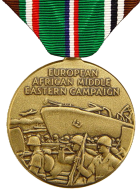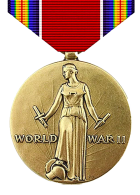The 56th Signal Battalion of the United States Army, was re-activated at Fort Jackson, South Carolina on January 23, 1941 from a Cadre supplied from the 50th Signal Battalion located at Camp McCoy, Wisconsin. In May 1941, the unit was complemented with a group of 460 Selective Service Civilian Draftees from the reception Centers at Camp Dix, NJ and Camp Upton, NY and initially assigned to the First Corps. The period of service for the personnel was to be for a period of one year in accordance with existing governmental regulation. As a result of the December 7, 1941 action by the Japanese at Pearl Harbor, and the declaration of war, the one year period of service was extended.
On June 1942 the Battalion left Fort Jackson for the staging area at Fort Dix, NJ and sailed the North Atlantic Ocean aboard the troopship SS Argentina, in convoy from the New York Port of Embarkation on July 1, 1942. The convoy arrived at Duncan, Scotland on July 12, 1942 and the unit was ferried across the Irish Sea to Belfast, Northern Ireland. During the stay in Northern Ireland the Battalion was assigned to the Fifth Corps and encamped at Carrickfergus and Lurgan where the unit strength was depleted in order to furnish manpower to other Signal units preparing for the North Africa Campaigns. Movement from Northern Ireland to Bristol, England was completed in November 1942 where the unit was reorganized with plans for additional equipment and personnel. An additional wire construction Company was added to the organization in January 1943 in Cadre form. During June 1943, many of the additions and replacements to the Battalion arrived directly from the Shenango Replacement Depot located in Camp Reynolds, Pa.
On June 6, 1944, elements of the Battalion engaged in OPERATION NEPTUNE landed on Omaha Beach, France with the First Army to furnish ship to shore communications for V Corps Headquarters and wire, radio and messenger communications for the Divisions and Corps troops ashore. During the Normandy campaign the Battalion performed normal communication functions, but following the Allied breakthrough, across France Belgium and Luxemburg, the Battalion was fully extended. Radio and messenger communications were continuous and wire networks were installed to the extent that supplies of wire and gasoline were available.
The winter Ardennes campaign proved the most trying test for the 56th Signal Battalion. Enemy shelling on all wire axis, mud, sleet and snow and impossible travel conditions required herculean efforts to keep communications functioning. At the end of hostilities, May 9, 1945 the Battalion had reached Pilsen, Czechoslovakia. My service with the Battalion began in May 1941 in the wire communications group and I remained with the Battalion in that capacity throughout, including the Initial D-Day Assault on the Normandy beaches to the end of hostilities in Pilsen, Czechoslovakia in May 1945. Our mission was to closely follow the actual combat troops and to ensure communications between the various units.
The assignment and close proximity to the fighting troops enabled involvement in the loss of life and devastation. I landed on the sandy beach of Normandy on the morning of D+1 aboard a Higgins landing craft and the prior days losses were evidenced by the sand covered, partially hidden fallen troops of the early hours of the attack and the masses of twisted metal of small boats and vehicles. The menace of enemy heavy artillery was a constant threat aimed at the landing operation that seemed like a steady flow of ship to shore reinforcements without any regard for the shelling. The fallen casualties, some piled on the beach area in orderly fashion, all wore the olive drab uniform of the American forces.
As recalled a short time later, this bloodstained olive drab was in sharp contrast to the slate blue uniform of the enemy forces as seen in grotesque positions of death found at the scene of the encirclement and slaughter in the area of Falaise, France in August 1944. There was no respite or escape for these troops, almost completely surrounded and trapped, as both the air and ground attack destroyed man, animal and machine without regard. W itnessed and heard from vantage points outside the encirclement, the air bombing attack was constant as was the sound of artillery. When our unit passed through the area shortly after some of the enemy had been able to escape through a small withdrawal route, the amount of incredible destruction and loss of life was evident.
The pain and horror of war was found here with both countless man and animal, some charred and burned, but still recognizable. Vehicles and other war machines, still burning, were upended and littered. Panzer Tanks, once powerful lethal weapons of war, were reduced to smoking hulks, some with the fire wasted bodies of once proud and majestic German youth draped in death across the outside. In my 335 days of combat service in Europe, which included the atrocities of the Buchenwald Concentration Camp, these recollected scenes in Falaise were among the most horrid and appalling. In this case, some that have experienced Falaise would say, justifiable inhumanity. A blessing it was to move on in pursuit, with this unforgettable scene behind us and the dreadful thoughts of those involved in the cleansing, to restore the once beautiful countryside of the waste and residue of war..
Battle Star Campaigns
Normandy, Northern France, Ardennes, Rhineland, Central Europe
Bronze Service Arrowhead - Initial Assault
335 Combat Days
1305 Combat Road Miles
Robert H. Searl












